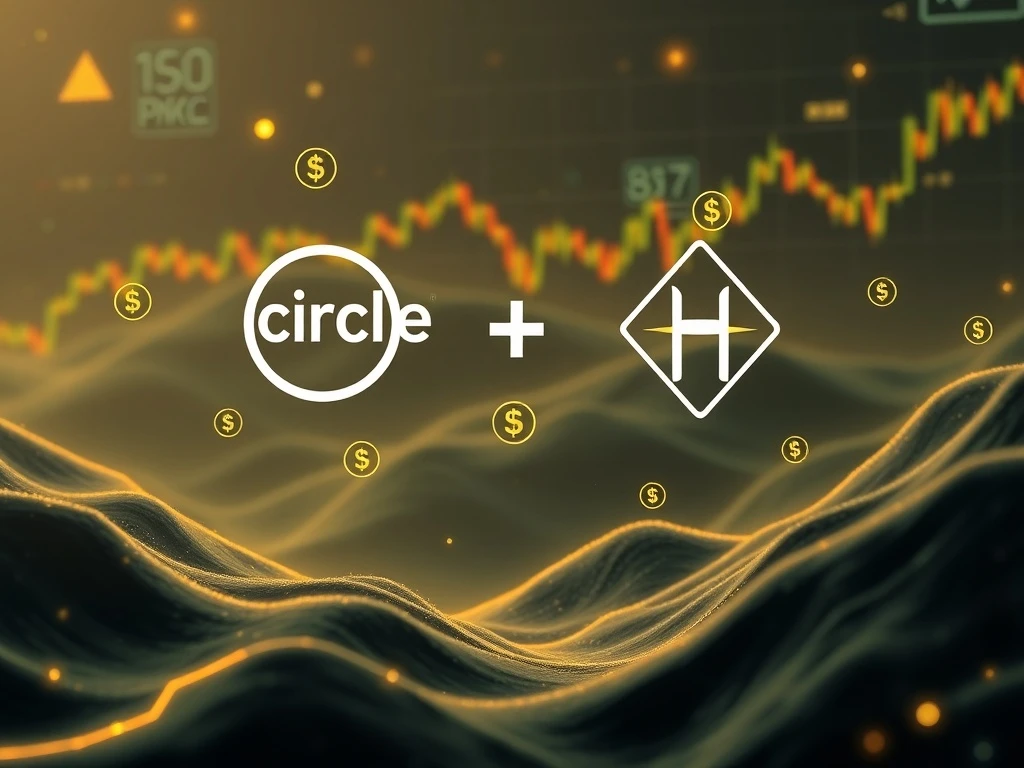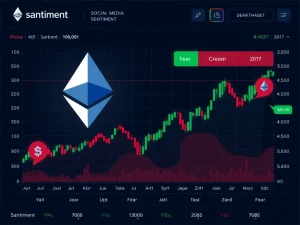Circle’s Strategic Crypto Investment Fuels Hyperliquid, Elevating Stablecoin Competition

The decentralized finance (DeFi) landscape is witnessing a significant shift. Leading stablecoin issuer Circle has made a strategic crypto investment in Hyperliquid, a prominent DeFi derivatives platform. This move introduces native USDC to Hyperliquid, thereby intensifying the already fierce stablecoin competition within the ecosystem. This development marks a pivotal moment for both entities, signaling Circle’s deeper integration into the high-growth DeFi sector and Hyperliquid’s expanding infrastructure.
Circle USDC: A Strategic Move into Hyperliquid
Circle, the issuer behind the widely adopted USDC stablecoin, is strategically expanding its presence within the Hyperliquid ecosystem. This initiative involves a direct investment, making Circle a holder of Hyperliquid’s native cryptocurrency, HYPE. Furthermore, Circle is actively considering becoming a validator for the protocol. This commitment underscores Circle’s belief in Hyperliquid’s potential and its role in the future of decentralized trading. The company, which recently went public on June 5, continues to solidify its position as a key player in the digital asset space.
The core of this expansion is the native deployment of Circle USDC on HyperEVM, Hyperliquid’s advanced smart contract layer. This integration is not merely a technical upgrade; it represents a foundational step towards enabling direct USDC deposits into Hyperliquid’s spot and perpetuals exchange on HyperCore. This direct integration promises several key benefits:
- Enhanced Liquidity: Native USDC can provide deeper liquidity pools for traders.
- Reduced Friction: Users will experience smoother transactions without bridging complexities.
- Increased Trust: Circle’s direct involvement often instills greater confidence among users.
Circle’s spokesperson confirmed to Crypto News Insights that today’s launch delivers on a roadmap announced back in July. This consistent execution highlights the strategic planning behind this significant partnership. Consequently, the DeFi community closely watches these developments, anticipating their impact on user experience and market dynamics.
Hyperliquid: A Rising Star in DeFi Derivatives
Hyperliquid stands out as a robust decentralized finance ecosystem specializing in DeFi derivatives trading. Launched nearly a year ago, its layer-1 network quickly gained traction. By July, the protocol had impressively surpassed $330 billion in trading volume. This rapid growth underscores Hyperliquid’s efficiency and its appeal to a broad base of traders. The platform offers a high-performance environment for perpetuals and other derivative instruments, attracting significant liquidity and user engagement.
The success of Hyperliquid can be attributed to several factors:
- Innovative Layer-1 Architecture: Provides speed and scalability for complex trading.
- Focus on Derivatives: Caters to a specific, high-demand segment of the DeFi market.
- Strong Community Engagement: Fosters active participation in governance and development.
This dynamic environment naturally fosters innovation, including the push for a native stablecoin. Therefore, Hyperliquid’s continued evolution remains a focal point for many crypto investors and developers.
Intensifying Stablecoin Competition on Hyperliquid
The stablecoin landscape on Hyperliquid has become a battleground for innovation and market share. In September, the protocol initiated a competition to select a partner for developing its own native stablecoin, USDH. This contest attracted bids from several major stablecoin issuers and prominent crypto firms. Notable contenders included Paxos, Frax, Sky, Agora, Ethena, OpenEden, BitGo, and Native Markets. This diverse participation highlighted the strategic importance of integrating a native stablecoin into a high-volume derivatives platform.
On Sunday, the Hyperliquid validator community announced its decision. They selected Native Markets to issue the upcoming native stablecoin, USDH. This choice followed a rigorous evaluation process. Validators on Hyperliquid, who are HYPE holders, play a crucial role in securing the blockchain, validating transactions, and participating in governance. The top 21 validators by stake form the active set, responsible for proposing and confirming blocks. Currently, approximately 430 million HYPE tokens are staked on the network, demonstrating significant community involvement. Prominent validators include Galaxy Digital, Flowdex, and the Hyper Foundation, which actively supports Hyperliquid’s ongoing development.
Circle’s move to deploy native Circle USDC directly onto HyperEVM adds another layer to this stablecoin competition. While Native Markets will issue USDH, the presence of a strong, established stablecoin like USDC offers users choice and enhances liquidity. This scenario could lead to a multi-stablecoin environment on Hyperliquid, benefiting users through diverse options and potentially tighter spreads. Therefore, the strategic interplay between USDH and USDC will be a key area to watch.
The Broader DeFi Landscape and Crypto Investment Trends
Decentralized finance (DeFi) continues its robust expansion into 2025. Real-world asset (RWA) tokenization and digital asset treasuries are driving substantial financial assets onto the blockchain. According to DefiLlama, the total value locked (TVL) across all protocols has surged to $158 billion as of Tuesday. This marks a significant increase from $117 billion in December, representing a 35% rise in approximately nine months. This growth signifies increasing institutional and retail confidence in DeFi’s capabilities.
Several factors contribute to this impressive growth:
- Institutional Adoption: More traditional financial entities are exploring DeFi opportunities.
- Technological Advancements: Improved scalability and security enhance user experience.
- Innovative Use Cases: RWA tokenization opens new avenues for capital deployment.
Even memecoin trading, once dismissed, has experienced a remarkable comeback. Pump.fun’s daily volume crossed $1 billion on Monday, illustrating the speculative yet vibrant nature of the crypto market. This resurgence highlights the diverse appeal of digital assets, from serious financial instruments to community-driven tokens. The overall bullish sentiment across the crypto market, including Bitcoin’s recent movements and the anticipation of Fed rate cuts, further fuels crypto investment interest. These macro trends create a fertile ground for platforms like Hyperliquid and stablecoins like USDC to thrive.
Impact and Future Outlook for DeFi Derivatives
Circle’s deepened engagement with Hyperliquid carries significant implications for the future of DeFi derivatives and the broader stablecoin market. The native integration of Circle USDC provides Hyperliquid users with a highly liquid and trusted stablecoin option. This move potentially attracts more institutional participants to the platform, as USDC is widely recognized and used across the crypto ecosystem. Furthermore, Circle’s consideration of becoming a validator strengthens the decentralization and security of Hyperliquid’s network. This commitment fosters a more robust and resilient trading environment.
The ongoing stablecoin competition on Hyperliquid, featuring both USDH and USDC, presents an interesting dynamic. It allows for market-driven innovation and offers users diverse stablecoin choices. This competition could lead to improved capital efficiency and more competitive trading fees. Ultimately, this benefits the end-user by providing better options for managing risk and executing trades. The growth in TVL across DeFi, coupled with renewed interest in various crypto sectors, positions platforms like Hyperliquid for continued expansion.
As the digital asset space matures, partnerships between established entities like Circle and innovative platforms like Hyperliquid become increasingly crucial. They drive adoption, enhance infrastructure, and ultimately contribute to the mainstream acceptance of decentralized finance. The evolution of Hyperliquid’s ecosystem, supported by strategic investments and native stablecoin integrations, will undoubtedly shape the future trajectory of DeFi derivatives. This makes it an exciting area for observation and participation for all involved in the crypto market.









